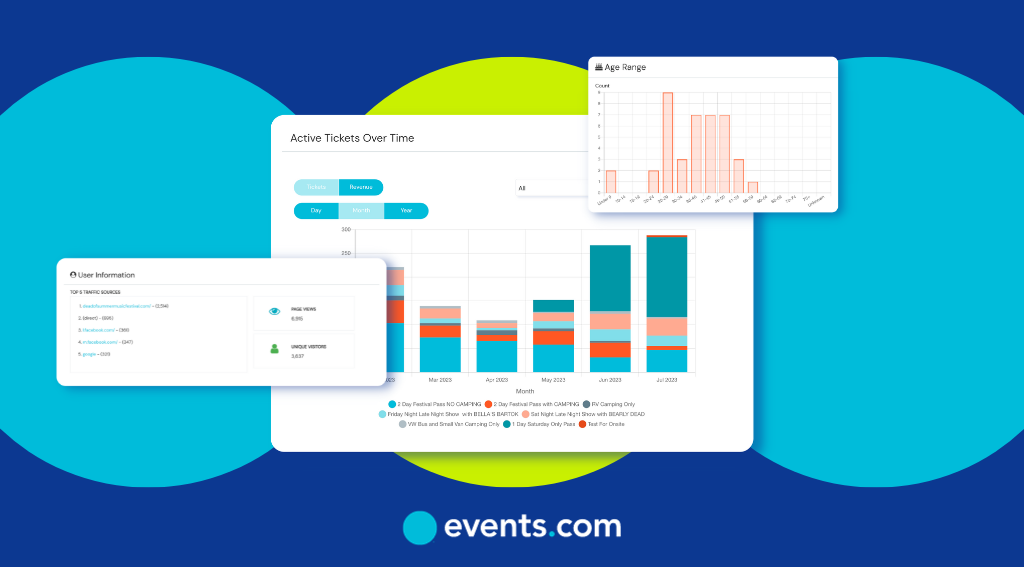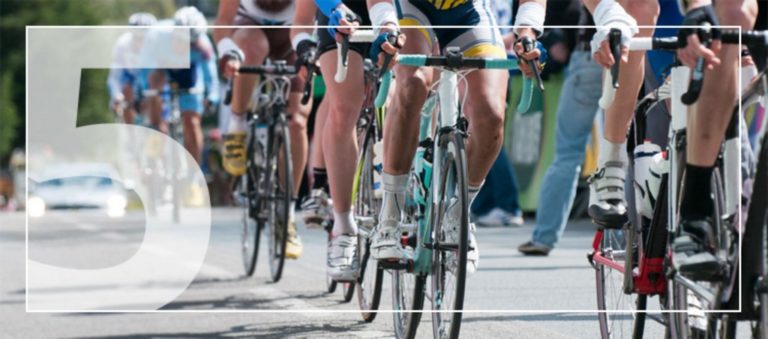You put a lot of time and energy into meticulously planning, organizing, and marketing your event. Understandably, you’d want it to be a hit. But how can you know for sure?
Establishing and measuring a set of clear event marketing key performance indicators (KPIs) is one of the best ways for an event planner to assess the success of their events. But why do they matter? And what success KPIs should you measure? Here’s what you need to know.
Why Is It Important to Measure Event Marketing KPIs?
Part of the event planning and marketing process is figuring out what goals you want to achieve. Event marketing KPIs allow you to determine if you met them.
Event KPIs can help you see what worked and where you fell short, enabling you to determine what you need to do to improve future events and ensure better experiences. And if you did meet your event goals, you can see what you did well so that you can continue hosting successful events and make future events even better.
Your event marketing metrics can help you with your current event, too. With an established set of KPIs, you can see whether or not you’re on track to achieve your goals. If not, you can adjust your efforts to ensure the best results. Let’s say, for instance, you realize you aren’t seeing the social media engagement you’d hope to get. Armed with that information, you can make effective changes to your existing strategy.
Measuring event marketing KPIs can help demonstrate the value of your event, which can come in handy if you’re looking to attract sponsors for future events. Your KPIs provide the concrete evidence many prospective sponsors need to know that your event is worth their investment. That evidence could be what turns potential sponsors into loyal, long-term partners.
11 KPIs That Measure the Effectiveness of Your Event Marketing
When it comes to how to measure event success, consider including the following KPIs:
1. Registrations and Ticket Sales
With total registrant and ticket sale data, you can see if you’re on track to reach your attendance goals well before the beginning of your event. Any lags in event registrations can highlight a need to amp up your marketing efforts or adjust your event marketing strategies to encourage more sales. Spikes, on the other hand, can help you identify which marketing tactics work best.
Along with registrations and ticket sales (over time and in total), you should be sure to pay attention to the following:
- Email signups
- Registrations by ticket type
- Registrations/sales by promotion type
- Event check-ins
2. Event Mentions and Engagement
Today, nearly three-quarters of people in the U.S. (246 million as of January 2023) have at least one social media account, and they spend an average of just over two hours a day scrolling through their feeds. As such, platforms like Facebook and Instagram have become popular places for event marketers to promote their upcoming events. An effective social media marketing strategy can go a long way in helping to spread the word about your upcoming event and attract more attendees.
Keeping track of event mentions, also known as social listening, is one way to monitor the effectiveness of your social media event marketing efforts and your engagement across the various platforms. These mentions allow you to see how people talk about your event in the wild. Using simple, unique event hashtags can help make things easier. Other social media event success metrics, including clicks, impressions, likes, comments, and shares, can also help you track and assess your engagement on social platforms.
3. Net Promoter Score (NPS)
The net promoter score (NPS) is a straightforward event marketing KPI based on a simple question: “How likely are you to recommend this event to friends?” It’s a common question that many event organizers include in their post-event surveys. Participants answer this question on a 0 (not at all likely) to 10 (extremely likely) scale, allowing you to assess attendee satisfaction with your event.
An NPS divides respondents into three categories:
- Promoters: those who scored your event a 9 to 10
- Passives: those who ranked your event 7 to 8
- Detractors: anyone who ranked your event 0 to 6
To determine your NPS, you can use the following formula:
- % of promoters (# of promoter scores/total # of respondents) – % of detractors (# of detractor scores/ total # of respondents)
4. Event Survey Completion and Data
Speaking of event surveys, you can learn a lot about the success of your event—and your event marketing efforts—by asking questions. Surveys are a great way to get inside the minds of your attendees and understand their satisfaction with your event.
Ideally, you want as many people to complete your event surveys as possible. After all, the more data you have, the better equipped you’ll be to ensure the most effective marketing and better event experiences in the future.
5. Qualified Leads
Are you looking to help your event sponsors generate more leads? If so, you’ll want to track the number of qualified leads your event attracts. You can generate and identify qualified sales leads in many ways, including event registration forms, during the event check-in process, and lead generation kiosks.
No matter how you go about it, be sure that you understand what makes a qualified lead for your sponsors. Collecting and sharing information from these event metrics can help you build a stronger relationship with your sponsors. Showcasing your ability to generate qualified leads may also come in handy for attracting new sponsors when you want to seek them.
6. New and Returning Attendees
Tracking new versus returning attendees helps you gauge the popularity of your event. While you want to attract more first-time event attendees, the number of repeat attendees you bring back can show you whether or not your event is resonating with your target audience and provide insight into the value you’re creating. A high attendee retention rate is a good indicator of success. A low retention rate, on the other hand, typically indicates a problem.
Another metric to keep an eye on is your attendee rate. In other words, how many people attended your event compared to your total number of registrants? You can do this by tracking check-ins. If you notice a low event or session attendance rate, you can take steps to pinpoint and address issues with registrants converting into actual attendees. For instance, you may find that you need to increase your marketing efforts as your event day approaches to generate excitement and ensure your registrants don’t forget.
7. Cost-to-Revenue
The revenue your event generates alone (your gross revenue) isn’t enough to indicate success. However, that figure becomes more important when you compare it to the total cost of organizing and hosting your event. The difference between your gross revenue and your total cost provides insight into how much profit — or loss — you generated and how you might be able to improve this ratio during future events.
A favorable cost-to-revenue ratio indicates a good return on investment (ROI). Along with being beneficial for you, it can also come in handy when it comes to attracting potential sponsors.
8. Customer Acquisition Cost
Customer acquisition cost (CAC) refers to how much it costs to gain new customers. It’s another KPI for events that can help you assess the effectiveness of your marketing efforts and your event ROI.
The simplest way to calculate your cost per attendee is to divide your total marketing costs by the number of ticket sales. You could also calculate CAC for each marketing channel you use (social media, email, search engine marketing, etc.) to see which ones generate the greatest ROI.
9. Post-Event Conversions
While attendee figures are essential KPIs, you also want to pay attention to post-event conversions. A post-event conversion is any meaningful action your attendees take after your event ends. It can take many forms, such as donations, email response rates, or requests for additional information. Whatever action you want your attendees to perform after your event, tracking how many people actually take it can help you measure your overall success.
10. Sponsorship Satisfaction
Sponsors play a vital role in events. For one thing, they provide additional funding, which you can use to bring your event to life and ensure better event experiences. They can also help you expand your reach and tap into new audiences, making it easier to attract more potential attendees. In return, they get increased brand awareness and access to more prospective leads.
To keep sponsors coming back, you want to ensure great experiences with you and your event. Surveys can be a valuable tool here, helping you assess sponsor satisfaction and determine areas for improvement. Satisfied sponsors are more likely to become long-term partners. They can also encourage prospective sponsors to partner with your brand.
11. Brand Loyalty
Brand loyalty refers to an individual’s positive feelings toward your brand. They’re more likely to purchase tickets to your event over a competitor’s. They’re also more likely to help promote your event, whether through word-of-mouth marketing or via their social media platforms. In short, building a base of loyal attendees can go a long way in helping boost the success of your events. You can measure this loyalty in many ways, including social media mentions, referrals, returning attendee rates, and event satisfaction surveys.
Automate Your Event Marketing KPI Tracking With Events.com
When it comes to tracking KPIs and measuring the success of your event marketing efforts, the right event technology makes all the difference. Events.com’s event management software gathers valuable data on marketing, registrations, ticket sales, and so much more. You can then use what you learn to evaluate your performance and make better, faster decisions for your events. Visit Events.com or contact us today to learn more!






